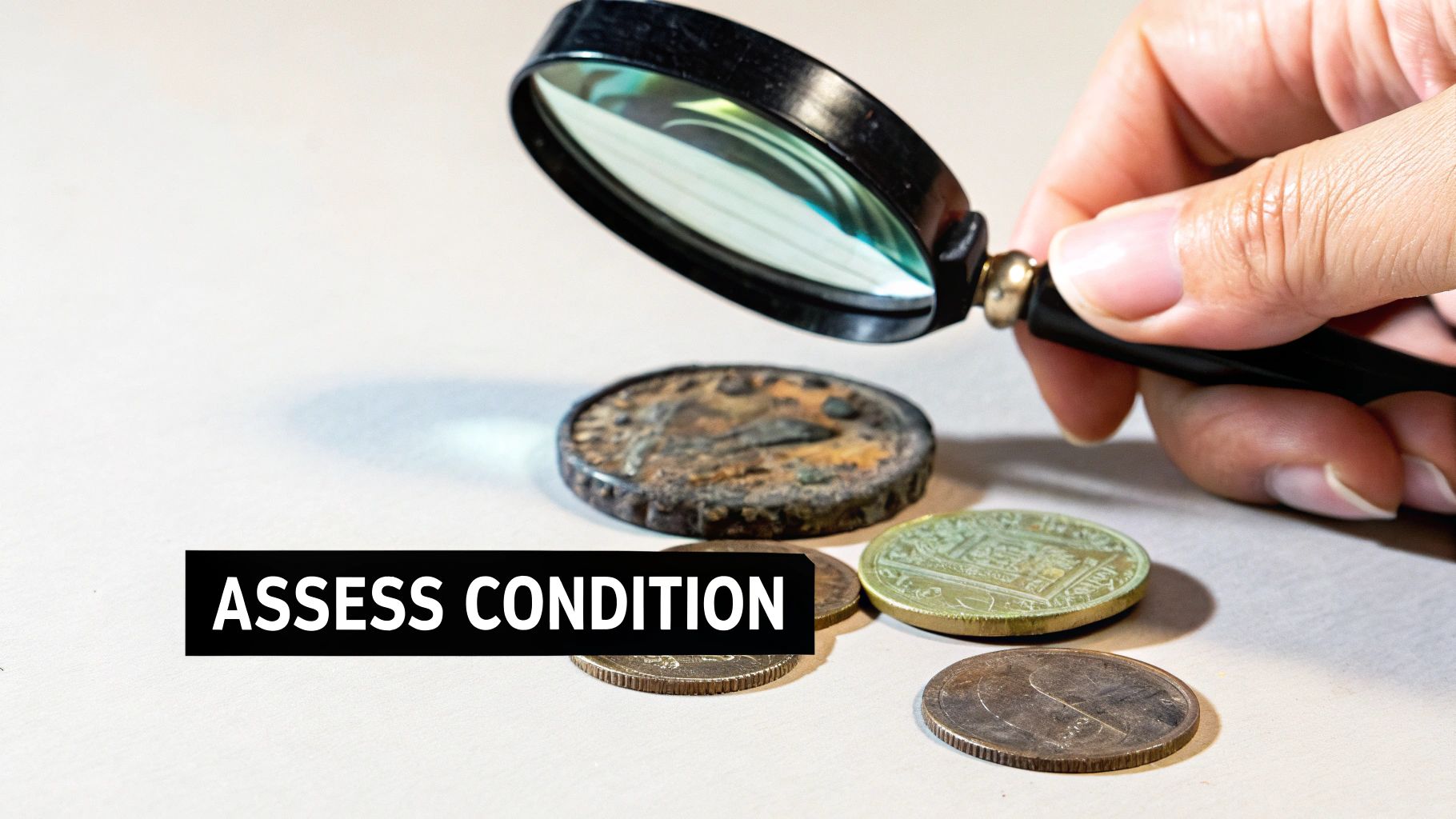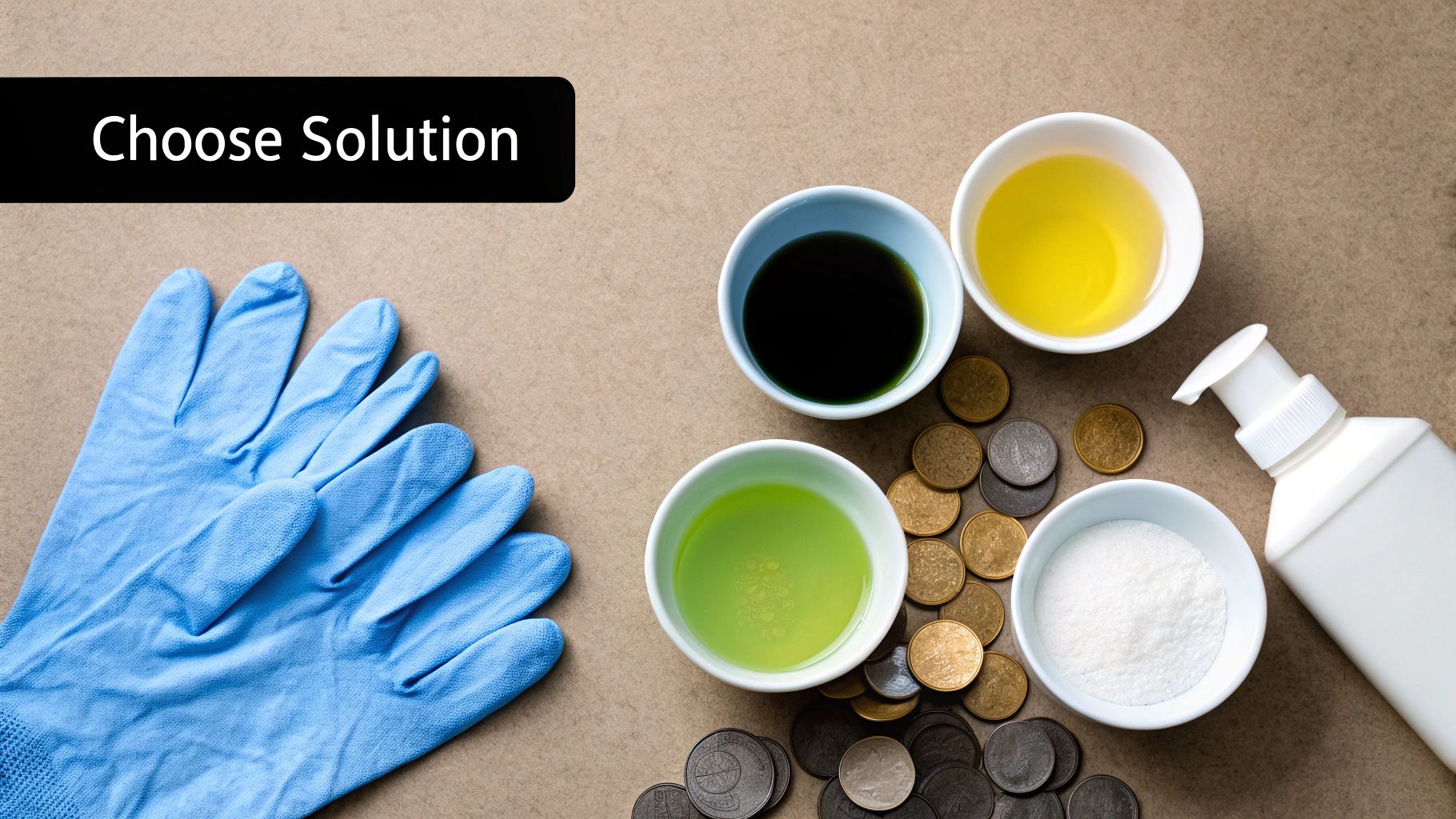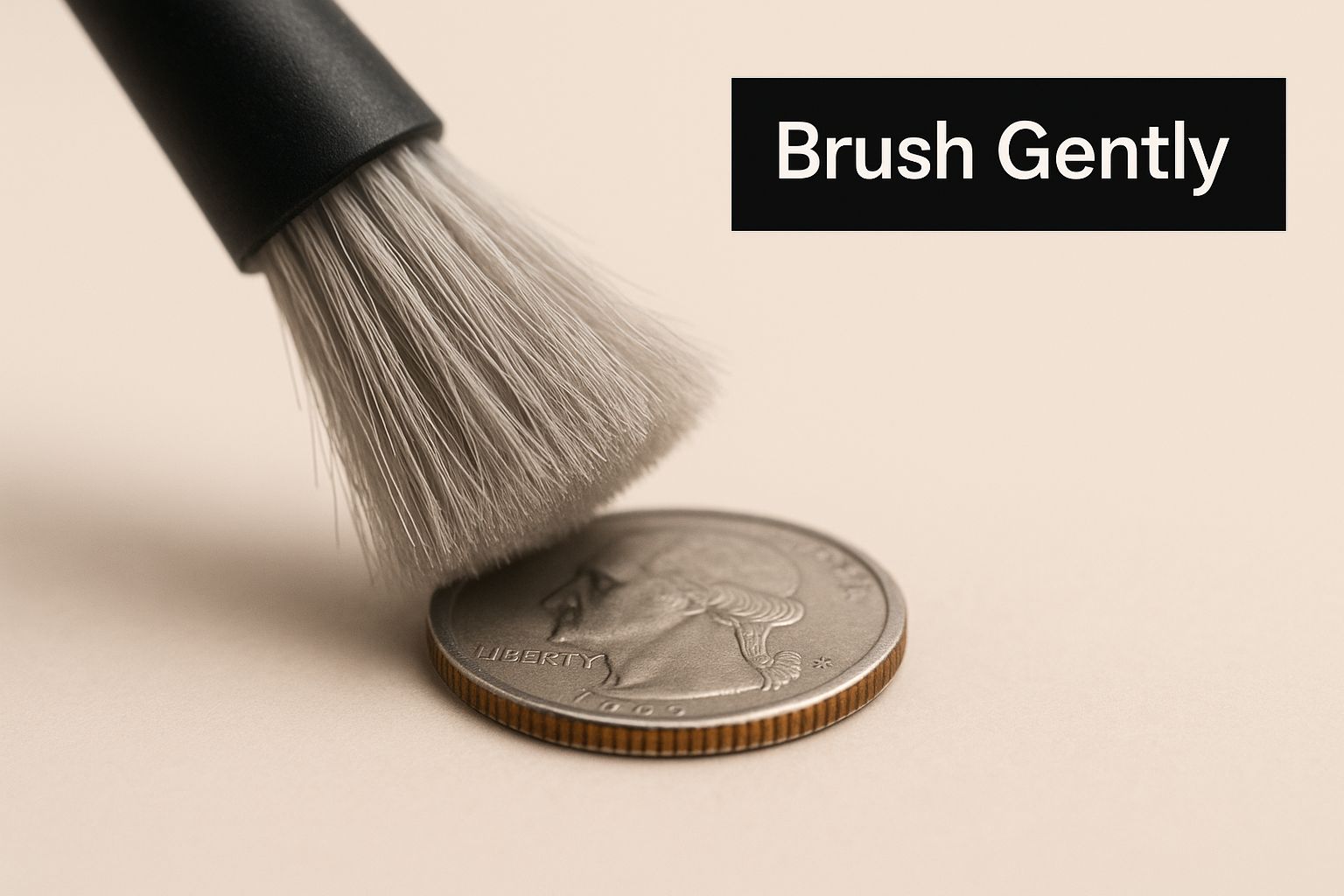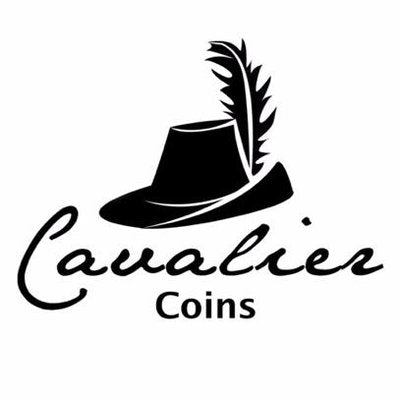Why Safe Cleaning Actually Matters (More Than You Think)

Many coin collectors, eager to make their treasures shine, might be tempted to clean their finds. However, this seemingly harmless act can actually damage a coin's value and historical importance. Think of it like restoring a classic painting: too much work can erase the details that make it valuable.
Understanding safe coin cleaning isn't just about aesthetics; it's about preservation.
The Danger of Over-Cleaning
One of the biggest misconceptions about coin cleaning is that cleaner means better. The opposite is often true. A coin's patina, that thin layer of tarnish, is a protective shield. It safeguards the metal from further corrosion and provides clues about the coin's age and authenticity.
Removing this patina can dramatically decrease a coin's value, sometimes by 50% or more. Improper cleaning can also introduce scratches and abrasions, further lowering its worth. UK authorities widely recommend that collectors and metal detectorists avoid cleaning rare coins entirely. Even minor abrasions or water exposure can result in a loss of up to 50% of the coin's market value. The Portable Antiquities Scheme (PAS) specifically advises against cleaning agents and encourages consulting professional numismatists if a coin needs attention.
The Professional Approach
Museum professionals and conservators in the UK understand the importance of preserving a coin's history. They rarely use harsh chemicals or abrasive techniques. Their focus is minimal intervention, prioritizing documentation and careful preservation over aggressive cleaning.
Even seemingly insignificant surface dirt can contain vital historical information, like fingerprints or traces of the environment where the coin circulated.
Preservation Over Perfection
Safe coin cleaning is about understanding the difference between corrosion and patina. Corrosion actively damages the coin, while patina is a sign of age and history. Before attempting any cleaning, carefully assess the coin's condition.
If you're unsure, consult a professional numismatist. Learning how to clean old coins safely isn't just a hobbyist skill; it's crucial for protecting numismatic history.
What Museum Professionals Actually Do (It's Surprising)

Forget the harsh cleaning methods you might see online. Museum professionals, including conservators at the British Museum and regional archaeological teams in the UK, adopt a surprisingly gentle approach to cleaning old coins. Their focus isn't on restoring a bright shine, but on preserving the coin's historical integrity.
Documentation Takes Precedence
Before any cleaning is considered, detailed documentation is crucial. This involves photographing the coin from various angles, recording its weight and dimensions, and analyzing its composition. This comprehensive record ensures that any changes from cleaning, no matter how small, are tracked.
The coin's surrounding environment and its context, such as its location within a hoard or archaeological site, are also documented. This information can be incredibly valuable, often as important as the coin itself.
Controlled Environments Are Key
Museum coins are housed in carefully controlled environments. Temperature and humidity are strictly regulated to prevent further corrosion and deterioration. These professionals understand that fluctuations in these conditions can accelerate damage, particularly for fragile coins.
Any necessary cleaning procedures take place within these controlled environments to minimize risk. This careful approach ensures the long-term preservation of these historical artifacts.
Minimal Intervention Is the Standard
Surveys of coin conservation best practices reveal a surprising statistic: the vast majority of professional archivists and archaeologists in the UK only rinse coins in distilled water if cleaning is absolutely necessary. Tap water, containing minerals and chlorine, can pose a risk to the metal.
It's estimated that fewer than 5% of professional curators use chemical cleaning on coins. This method is reserved for situations where scientific analysis can be conducted beforehand to prevent damage. You can explore this topic further here. This cautious approach highlights a key difference between amateur and professional cleaning: less is always more.
Specialized Tools, Simple Techniques
Museum professionals utilize specialized tools, though often simpler than one might expect. Soft brushes, distilled water, and controlled air puffs are the preferred tools. They focus on gently removing loose dirt and debris, steering clear of any abrasive methods that could scratch the coin's surface.
This meticulous approach, combined with thorough documentation, allows museums to protect these numismatic treasures for generations to come. This philosophy of prioritizing preservation should guide every coin collector's cleaning practices.
Safe Methods You Can Actually Use at Home
While professional conservation is often the best route for valuable coins, there are a few safe cleaning methods you can try at home for less valuable pieces. Remember, any cleaning carries inherent risk. Proceed with extreme caution and consider the potential impact on your coin's value. If you're uncertain, consulting a professional numismatist is always the best course of action. You might be interested in: How to master cleaning dirty and rusty coins.
The Distilled Water Bath
The safest cleaning method for appropriate coins involves distilled water. Tap water contains minerals and chemicals that can damage a coin's surface. Distilled water, however, is purified and less likely to cause this harm.
- Use room temperature distilled water: Avoid hot or cold water, which can shock the metal.
- Soak briefly: Submerge the coin for no more than 15-30 minutes. Over-soaking can lead to corrosion.
- Gentle handling: Use soft plastic tweezers to handle the coin and avoid direct contact with your fingers.
- Air dry: Place the coin on a clean, soft cloth to air dry completely after soaking. Avoid rubbing, as this can create scratches.
Soft Brush Technique
For coins with encrusted dirt, a soft-bristle brush can be helpful. Using the correct type of brush and the right technique is crucial.
- Choose the right brush: Opt for a soft-bristle brush specifically designed for coin cleaning or a very soft artist's brush. Avoid toothbrushes with stiff bristles.
- Brush gently: Use light, circular motions and avoid scrubbing back and forth, which can cause scratches.
- Magnification is key: Use a magnifying glass to monitor your progress and ensure you aren't causing any damage.

This infographic visualizes brushing a coin with a soft-bristled brush. The key takeaway? Utmost care is essential when brushing a coin’s surface. Even soft brushes can create microscopic scratches that detract from the coin's value if used with too much force.
The following table summarizes the key differences between the cleaning methods discussed:
Safe Cleaning Methods Comparison: A detailed comparison of different safe cleaning approaches, their risk levels, and appropriate applications.
| Method | Risk Level | Best For | Equipment Needed | Time Required |
|---|---|---|---|---|
| Distilled Water Bath | Low | Loose dirt and debris | Distilled water, soft plastic tweezers, soft cloth | 15-30 minutes |
| Soft Brush Technique | Medium | Encrusted dirt | Soft-bristle brush, magnifying glass | Variable, depending on the level of dirt |
As shown in the table, the distilled water bath is generally safer and quicker for removing loose dirt, while the soft brush technique requires more care and time but can handle more stubborn encrustations.
Knowing When to Stop
Perhaps the most important aspect of safe coin cleaning is knowing when to stop. If you encounter any resistance or notice changes to the coin’s surface, stop immediately and consult a professional.
- Warning signs: Look for any signs of discoloration, pitting, or scratching.
- Don't force it: If dirt doesn't come off easily with gentle cleaning, don’t try to force it.
- Seek expert advice: When unsure about the best course of action, contact a professional coin conservator. They can assess the coin and recommend the appropriate treatment. Preserving a coin’s historical integrity is always more valuable than a shiny surface. By understanding the risks and following these guidelines, you can help maintain the value and historical significance of your coins.
Dangerous Methods That Destroy Coins Instantly
Some coin cleaning methods are so damaging they can obliterate a coin's value in mere seconds. Unfortunately, misinformation persists online and even in some hobby publications, leading collectors astray. Let's explore some practices to avoid entirely if you want to preserve your numismatic treasures.
The Destructive Power of Chemical Dips
Chemical dips are often presented as quick fixes for dirty coins. However, these dips, whether acidic or alkaline, can cause irreversible damage. They strip away not only dirt but also the crucial patina, the protective layer that gives a coin its character and historical context. Removing this patina can significantly devalue your coins, especially in the eyes of serious collectors.
While a coin might appear cleaner immediately after a chemical bath, it’s now far more vulnerable to future corrosion. The long-term damage far outweighs any perceived short-term aesthetic "improvement." Even a seemingly minor dip in a harsh chemical can create microscopic pitting that weakens the coin's structure over time.
Abrasive Polishes: A Recipe for Disaster
Another common culprit in coin destruction is the use of abrasive polishes. Products containing harsh grit or even common household cleaners can scratch the delicate surface of a coin, removing crucial details and historical evidence. These scratches, sometimes invisible to the naked eye, drastically reduce a coin’s value.
The polishing process itself can also thin the coin, making it more fragile and prone to bending or breaking. Think of it like trying to polish a delicate antique; the damage inflicted would be irreparable. Coins deserve the same gentle consideration.
Debunking the Myths of Household Cleaners
While household cleaners are effective for kitchen surfaces, they can be devastating for coins. The chemicals in these products can cause etching, discoloration, and even dissolve portions of the coin's metal. These effects are particularly damaging to older coins, often made of softer metals.
One common misconception is that baking soda is a safe cleaning solution for coins. However, even baking soda can be slightly abrasive and alter a coin's surface over time. The effects of these seemingly minor cleaning mistakes can compound, leading to significant damage that often manifests months or years later, making it difficult to trace the cause. Prioritizing safe handling and cleaning practices is paramount for preserving your valuable coins.
Real Horror Stories: When Good Intentions Go Wrong
The allure of a gleaming coin can be strong. It's tempting to scrub away what looks like dirt, restoring a coin to its former glory. However, this seemingly harmless act can be disastrous for the coin's value and historical significance. Improper cleaning can cause irreversible damage, turning a valuable treasure into a damaged piece of metal. This section explores real-world examples of how improper cleaning has destroyed numismatic treasures, highlighting the importance of safe coin cleaning practices.
The Tragedy of the Scrubbed Silver
Imagine a blackened silver coin, unearthed after centuries in the ground. A novice collector, eager to improve its appearance, vigorously scrubs the coin with a wire brush. The result is tragic. Deep scratches mar the surface, obliterating fine details. The coin's value plummets. What was once a historical artifact is now a damaged piece of metal, its story partially erased. This scenario, unfortunately, is all too common.
Chemical Baths and the Vanishing Patina
Another common cleaning mistake involves using harsh chemicals. Dipping a coin in a chemical bath might seem like a quick fix, but it can strip away the patina. Patina is the delicate layer of tarnish that protects the coin and provides clues to its age and authenticity. A coin stripped of its patina loses its historical context and becomes more vulnerable to future corrosion. This accelerated deterioration can render a once-valuable coin practically worthless.
The Cunetio Hoard: A Cautionary Tale
The Cunetio hoard, discovered in 1978 near Mildenhall, Wiltshire, provides a powerful example of the importance of preservation. This hoard consisted of 54,951 Roman coins—the largest ever found in Roman Britain. Experts estimate that if these coins had been subjected to standard collector cleaning techniques—like scrubbing or chemical dips—up to 90% of their historical and numismatic value could have been lost. Learn more about the Cunetio Hoard at the Wiltshire Museum. This discovery underscores the importance of preservation over perceived aesthetic improvement.
Lost History: The Price of Impatience
The true cost of improper cleaning extends beyond monetary value. When a coin’s surface is damaged, crucial historical details are lost forever. Microscopic scratches can obliterate mint marks, inscriptions, and even the subtle wear patterns that reveal how a coin circulated. This loss of information diminishes the coin's historical significance and hinders researchers' ability to understand its past. The irony is tragic: in attempting to improve a coin's appearance, we risk destroying the very history it embodies. Understanding safe cleaning methods is vital for preserving the past. These real-world examples serve as powerful reminders that patience and careful consideration are essential when handling old coins. Conserving a coin's history is always more valuable than a temporarily brighter shine.
When to Call in the Experts (And How to Find Them)
Knowing when to seek professional help can save a coin from irreparable harm and maintain its value. This involves recognizing the difference between issues you can handle at home and those best left to trained professionals. You might be interested in: Seven tips for buying collectable coins.
Identifying Coins That Need Expert Care
Several signs indicate a coin requires professional attention. For example, unusual or aggressive corrosion, especially if it obscures details, often needs specialized treatment. Similarly, historically or archaeologically significant coins, potentially from a hoard, benefit from expert documentation and conservation.
-
Unstable Surfaces: If your coin's surface seems flaky, powdery, or actively deteriorating, consult a professional. Trying to clean it yourself might worsen the damage.
-
Valuable or Rare Coins: For coins with significant monetary or historical value, professional advice is always recommended. The risk of accidental damage is greater than any potential benefit from DIY cleaning.
-
Unidentified Substances: If you find an unknown substance on a coin, don't try to remove it. A professional can identify the substance and recommend the correct course of action.
To help you decide whether to tackle coin cleaning yourself or seek professional help, we've created a handy decision matrix. It outlines various coin conditions, the suitability of DIY cleaning, the potential need for professional intervention, the urgency level, and typical costs involved.
Professional vs DIY Decision Matrix: A practical guide to determining when professional intervention is necessary based on coin characteristics and condition.
| Coin Condition | DIY Safe | Professional Required | Urgency Level | Typical Cost |
|---|---|---|---|---|
| Light Tarnish | Yes | No | Low | Low |
| Moderate Tarnish | Maybe | Possibly | Medium | Moderate |
| Heavy Tarnish/Corrosion | No | Yes | High | Moderate - High |
| Unstable Surface | No | Yes | High | High |
| Unknown Substance Present | No | Yes | High | Varies |
| Damaged (e.g., bent, cracked) | No | Yes | Medium | High |
| Extremely Valuable/Rare | No | Yes | Low | Varies |
This table provides a general guideline. Always err on the side of caution when dealing with potentially valuable or delicate coins.
Locating Qualified Professionals in the UK
Finding a qualified coin conservator in the UK might seem daunting, but resources are available. The British Numismatic Society offers a member directory; some specialize in conservation. Additionally, museums like the British Museum can provide referrals.
Understanding Costs and Services
Professional coin conservation costs vary depending on the coin's condition and the treatment's complexity. A basic assessment might cost a small amount, while full conservation can be more substantial. Requesting a written estimate beforehand ensures clarity and avoids surprises.
Different professional services exist. Basic condition assessment determines a coin's state and provides care recommendations. Full conservation treatment involves cleaning, stabilizing, and preserving the coin. Understanding these services and their associated costs helps you make informed decisions.
Keeping Your Coins Perfect After Cleaning
Safely cleaning your coins is only half the battle. Preserving their pristine condition requires proper storage, much like protecting a classic car from the elements after a thorough wash. Even the most meticulous cleaning can be undone by inadequate storage.
Essential Storage Practices
The right storage materials are essential for long-term preservation. Avoid materials that can react with the metal of your coins. For example, PVC plastic can release chemicals that corrode coins. Instead, choose archival-quality materials like inert plastic flips, Mylar sleeves, or acid-free paper envelopes. These are designed specifically for long-term storage and prevent chemical reactions.
You might be interested in: The Allure of Silver Coins.
Controlling the Environment
Environmental factors, particularly temperature and humidity, significantly impact a coin's condition over time. Fluctuations can accelerate corrosion and damage. Ideally, store your coins in a stable environment with moderate temperature and humidity. Avoid extremes like attics or basements, where these factors can vary drastically.
Ongoing Maintenance and Monitoring
Even with proper storage, regularly inspect your collection for signs of deterioration. This helps you catch and address potential issues early on. Look for discoloration, spotting, or corrosion. Early detection is key to preventing further damage. Also, avoid handling coins directly. Use cotton gloves or soft plastic tweezers to minimize skin contact and the transfer of oils and acids.
Storage Solutions for Every Collection
Different storage solutions suit various needs and budgets. Archival holders offer basic protection for individual coins. Albums or cabinets designed for coins provide organization and better protection for larger collections. For the most valuable coins, professional museum-quality systems offer the highest level of preservation, often using inert gas environments and specialized climate control.
By following these preservation principles, you can protect your coins and maintain their value for generations. Proper storage ensures your cleaning efforts aren't wasted, preserving your collection's long-term integrity and historical significance.
Ready to expand your collection? Explore a wide variety of coins and banknotes at Cavalier Coins Ltd.

